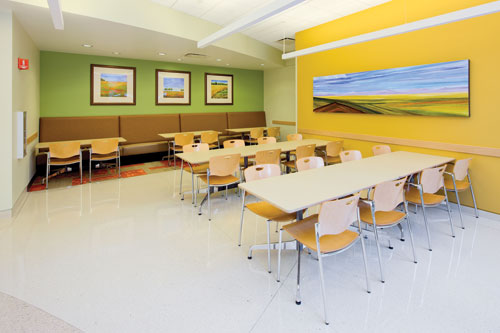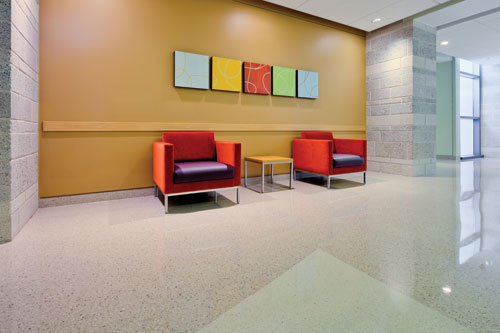Functional Color and Design in Healthcare Environments
ROOM BY ROOM: COLOR RECOMMENDATIONS
According to Melinda Gray, senior color consultant at Glidden Professional: “There is no one color or palette of colors that can be specified to guarantee healing in healthcare settings. In order to create an atmosphere in the hospital setting that appeals to all of the five senses, the design professional can define a number of color and design goals for major areas and departments. From public spaces to operating rooms, there are numerous ways to specify color to enhance the hospital setting.” The following is a review of many typical healthcare departments. To provide visual clarity and to enhance the healing process for patients, to improve the environment for caregivers and to enhance the working atmosphere for staff the following design recommendations are based on current color and EBD theories.
Public Spaces
Public spaces in a hospital range from lobbies and waiting rooms, to corridors, nursing stations and cafeterias. Lobbies and waiting rooms welcome the patient and their family to the healthcare setting. These areas should be welcoming and promote social interaction through comfortable, movable furniture and different levels of lighting that can offer some control to visitors. Many designers choose cool colors where wait times will be lengthy and add color elements for positive distraction. The palette chosen for waiting areas should be calming and soothing with a variety of color accents and art for visual interest.
 |
This small-scale cafeteria designed for Banner Ironwood Medical Center demonstrates how the use of bright colors and images of nature provide a diversion from a typical hospital setting. Photo by Ross Cooperthwaite: SmithGroupJJR |
Corridors consume large areas within the hospital. Generally, corridors in public spaces can be painted using a wide variety of colors. Designers may choose to incorporate warm and visually comforting colors for these vast spaces. Visual calmness when colors are being selected for corridors can be important when finalizing a palette for other parts of the hospital. For example, in surgical and intensive care corridors, the design professional might select cooler tones to suggest tranquility. In contrast, bright colors may be used in the corridors of the pediatric wing of the hospital. Sections of long corridors can be broken up with color blocking to provide interest, color and ease in navigation. Accenting ends of corridors provides visual cues for visitors and can identify destinations. The use of color in corridors can be the visual mechanism that provides the continuity and essence of the services on each floor. Color selections should include a variety of hues and avoid the institutional stereotypes of the past.
Lighting in the corridor is also important. Diffused lighting in corridors is preferable to the use of overhead fluorescents. Soft lighting placed in cornices or sidewall soffits avoids the institutional appearance and glare of overhead fluorescent lighting. Lighting can be used to illuminate a color accent, a change in direction of the corridor or as a means to add to the atmosphere of a waiting room.
Nurses' stations are critical to the healthcare process and must be easily identified by visitors and staff. Friendly, cheerful color selections are important for these spaces. Every effort should be made to connect decentralized nursing stations, through color and design to the main desk. This connection is important in making staff feel emotionally linked to the medical team.
Cafeterias, dining and gift areas are places of diversion and a time to escape from the typical hospital setting. Design professionals use these areas as a place to create an entirely different atmosphere from one that has been established in the main healthcare facility. In general, the designer should use the following design concepts:
- Create a unique atmosphere
- Provide an oasis from the real world
- Use a distinctive color palette
- Provide access to nature
- Select furniture that promotes social interaction
- Create small, flexible groupings
- Enhance relative privacy
- Design to enhance the dining experience
As mentioned earlier, many professionals are turning to the hospitality industry for inspiration for healthcare settings.
 |
This brightly colored seating respite in Banner Ironwood Medical Center in San Tan Valley, Arizona, also acts as a wayfinding accent along a main corridor. Photo by Ross Cooperthwaite: SmithGroupJJR |









